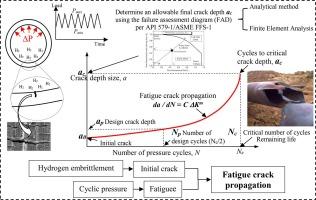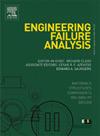氢脆对循环压力荷载下 API 5L X52 钢管剩余寿命和疲劳裂纹增长率的影响
IF 4.4
2区 工程技术
Q1 ENGINEERING, MECHANICAL
引用次数: 0
摘要
通过现有的天然气管道网络输送氢气为能源储存和输送提供了一个高效的解决方案。利用多余的可再生能源发电产生的氢气可以通过现有的 API 5L 钢制管道进行输送。近年来,通过现有天然气管道输送氢气的需求日益增长。因此,需要进行数值和实验测试,以验证和确保将用于加压氢气运输的 API 5L 钢制管道的机械完整性。内部压力负荷可能会加速氢气在管道内壁的扩散,从而加剧钢管的氢脆。此外,预裂纹管道主要在随时间变化的周期性压力加载下容易快速失效,从而导致疲劳裂纹扩展。同时,经过几个加载周期后,初始裂缝会扩展到临界尺寸。此时,可以估算出管道的剩余使用寿命,并确定检查间隔时间。本文主要研究 API 5L 钢制管道在循环压力加载下的氢脆问题。加压氢气通过管道网络进行输送,消耗节点的需求量会周期性变化。由此产生的随时间变化的压力曲线被视为对 API 5L 钢级材料制成的预开裂管道内壁的循环加载。通过数值建模,可以预测疲劳裂纹的演变,并估算出管道的剩余使用寿命。本文中介绍的开发方法基于 ASME B31.12 标准,该标准参照 ASME BPVC 第 VIII 章第 3 分部第 KD-10 条概述了氢气管道的指导原则。本文章由计算机程序翻译,如有差异,请以英文原文为准。

Hydrogen embrittlement effects on remaining life and fatigue crack growth rate in API 5L X52 steel pipelines under cyclic pressure loading
Transporting hydrogen gas through the existing natural gas pipeline network offers an efficient solution for energy storage and conveyance. Hydrogen generated from excess renewable electricity can be conveyed through the API 5L steel-made pipelines that already exist. In recent years, there has been a growing demand for the transportation of hydrogen through existing gas pipelines. Therefore, numerical and experimental tests are required to verify and ensure the mechanical integrity of the API 5L steel pipelines that will be used for pressurized hydrogen transportation. Internal pressure loading is likely to accelerate hydrogen diffusion through the internal pipe wall and consequently accentuate the hydrogen embrittlement of steel pipelines. Furthermore, pre-cracked pipelines are susceptible to quick failure mainly under a time-dependent cyclic pressure loading that drives fatigue crack propagation. Meanwhile, after several loading cycles, the initial cracks will propagate to a critical size. At this point, the remaining service life of the pipeline can be estimated, and inspection intervals can be determined. This paper focuses on the hydrogen embrittlement of API 5L steel-made pipeline under cyclic pressure loading. Pressurized hydrogen gas is transported through a network of pipelines where demands at consumption nodes vary periodically. The resulting pressure profile over time is considered a cyclic loading on the internal wall of a pre-cracked pipeline made of API 5L steel-grade material. Numerical modeling has allowed the prediction of fatigue crack evolution and estimation of the remaining service life of the pipeline. The developed methodology presented in this paper is based on the ASME B31.12 standard, which outlines the guidelines for hydrogen pipelines with reference to the ASME BPVC Section VIII, Division 3, Article KD-10.
求助全文
通过发布文献求助,成功后即可免费获取论文全文。
去求助
来源期刊

Engineering Failure Analysis
工程技术-材料科学:表征与测试
CiteScore
7.70
自引率
20.00%
发文量
956
审稿时长
47 days
期刊介绍:
Engineering Failure Analysis publishes research papers describing the analysis of engineering failures and related studies.
Papers relating to the structure, properties and behaviour of engineering materials are encouraged, particularly those which also involve the detailed application of materials parameters to problems in engineering structures, components and design. In addition to the area of materials engineering, the interacting fields of mechanical, manufacturing, aeronautical, civil, chemical, corrosion and design engineering are considered relevant. Activity should be directed at analysing engineering failures and carrying out research to help reduce the incidences of failures and to extend the operating horizons of engineering materials.
Emphasis is placed on the mechanical properties of materials and their behaviour when influenced by structure, process and environment. Metallic, polymeric, ceramic and natural materials are all included and the application of these materials to real engineering situations should be emphasised. The use of a case-study based approach is also encouraged.
Engineering Failure Analysis provides essential reference material and critical feedback into the design process thereby contributing to the prevention of engineering failures in the future. All submissions will be subject to peer review from leading experts in the field.
 求助内容:
求助内容: 应助结果提醒方式:
应助结果提醒方式:


